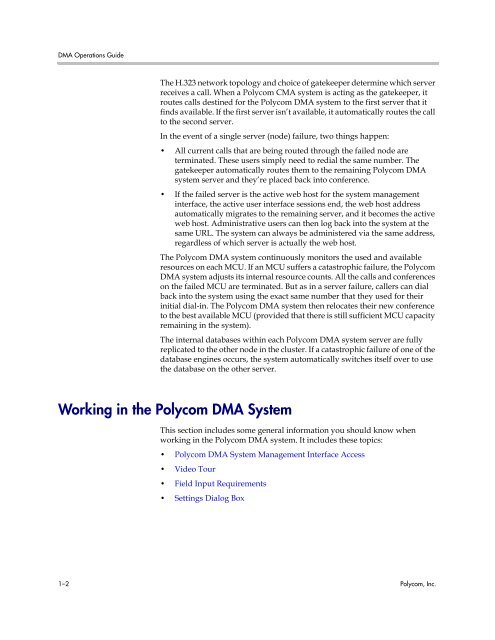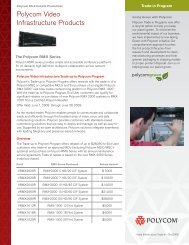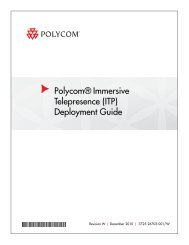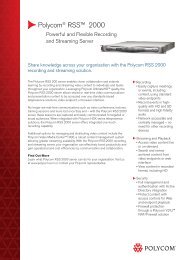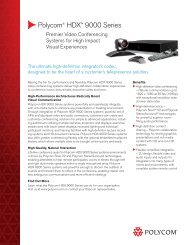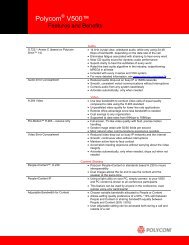Polycom DMA 7000 System Operations Guide
Polycom DMA 7000 System Operations Guide
Polycom DMA 7000 System Operations Guide
You also want an ePaper? Increase the reach of your titles
YUMPU automatically turns print PDFs into web optimized ePapers that Google loves.
<strong>DMA</strong> <strong>Operations</strong> <strong>Guide</strong><br />
The H.323 network topology and choice of gatekeeper determine which server<br />
receives a call. When a <strong>Polycom</strong> CMA system is acting as the gatekeeper, it<br />
routes calls destined for the <strong>Polycom</strong> <strong>DMA</strong> system to the first server that it<br />
finds available. If the first server isn’t available, it automatically routes the call<br />
to the second server.<br />
In the event of a single server (node) failure, two things happen:<br />
• All current calls that are being routed through the failed node are<br />
terminated. These users simply need to redial the same number. The<br />
gatekeeper automatically routes them to the remaining <strong>Polycom</strong> <strong>DMA</strong><br />
system server and they’re placed back into conference.<br />
• If the failed server is the active web host for the system management<br />
interface, the active user interface sessions end, the web host address<br />
automatically migrates to the remaining server, and it becomes the active<br />
web host. Administrative users can then log back into the system at the<br />
same URL. The system can always be administered via the same address,<br />
regardless of which server is actually the web host.<br />
The <strong>Polycom</strong> <strong>DMA</strong> system continuously monitors the used and available<br />
resources on each MCU. If an MCU suffers a catastrophic failure, the <strong>Polycom</strong><br />
<strong>DMA</strong> system adjusts its internal resource counts. All the calls and conferences<br />
on the failed MCU are terminated. But as in a server failure, callers can dial<br />
back into the system using the exact same number that they used for their<br />
initial dial-in. The <strong>Polycom</strong> <strong>DMA</strong> system then relocates their new conference<br />
to the best available MCU (provided that there is still sufficient MCU capacity<br />
remaining in the system).<br />
The internal databases within each <strong>Polycom</strong> <strong>DMA</strong> system server are fully<br />
replicated to the other node in the cluster. If a catastrophic failure of one of the<br />
database engines occurs, the system automatically switches itself over to use<br />
the database on the other server.<br />
Working in the <strong>Polycom</strong> <strong>DMA</strong> <strong>System</strong><br />
This section includes some general information you should know when<br />
working in the <strong>Polycom</strong> <strong>DMA</strong> system. It includes these topics:<br />
• <strong>Polycom</strong> <strong>DMA</strong> <strong>System</strong> Management Interface Access<br />
• Video Tour<br />
• Field Input Requirements<br />
• Settings Dialog Box<br />
1–2 <strong>Polycom</strong>, Inc.


